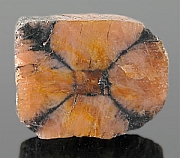Description
When cutting most pleochroic gemstones such as iolite and tanzanite, the trick is to minimize the pleochroism and maximize the single best color. With andalusite the opposite applies: cutters try to orient the gem to get a pleasing mix of orange-brown and a yellowish green or gold. When they succeed, andalusite looks quite unlike any other gemstone with patterns of color dancing around the facets. The best color play is seen in fancy shapes, particularly rectangular cushion shapes.
In the past andalusite was sometimes called "poor man's alexandrite" because it offered color play at a relatively low price. Andalusite does not really resemble alexandrite, which changes from green to red in different light. In fact andalusite is not a color change stone at all because the colors are present at the same time.
Andalusite is named after Andalusia, the province of Spain where it was first discovered, though today andalusite is mined in Brazil and Sri Lanka.
See also
alexandrite, iolite, and tanzanite |
faceted andalusite
faceted andalusite with distinctive pleochroism
chiasolite, a variety of the mineral andalusite, with its distinctive |


